Definition: Cost classification is the logical process of categorising the different costs involved in a business process according to their type, nature, frequency and other features to fulfil accounting objectives and facilitate economic analysis. Cost refers to the value sacrificed with the aim of gaining something in return. Every business process involves some cost. It is the basis of profit determination for an organisation.
Knowing about the different expenses facilitate the procedure of cost accounting in an organization.
A particular cost can be allocated under multiple categories. For instance; salary paid to an employee is a labour cost as well as a fixed cost. Moreover, the different elements of cost classification are linked to each other in one or the other way.
Content: Cost Classification
Basis of Classification
There are various kinds of cost incurred in the production of goods or services, and these costs are categorised systematically.
Some of the principal basis on which different costs can be allocated are as follows: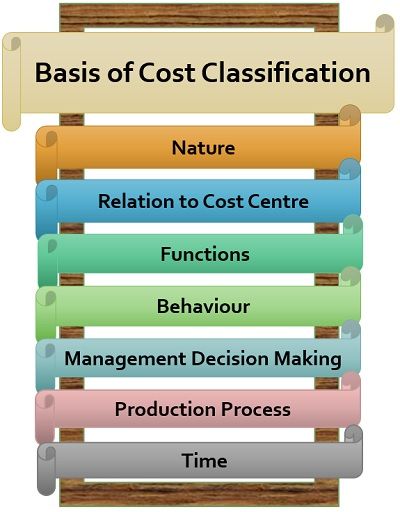
Cost Classification by Nature
The cost can be differentiated by its nature or the purpose for which it has occurred.
It can be treated as an expense under this category and the expenses so incurred is divided as follows: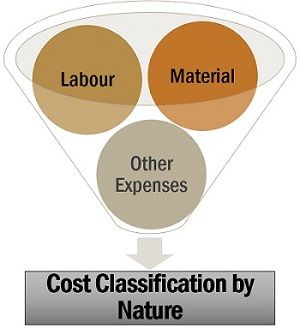
- Material: Material cost is the cost of the raw material and its related cost such as procurement cost, taxes, insurance, freight inwards, etc.
- Labour: Labour cost is the salary and wages paid to the employees, i.e. permanent, temporary or contractual employees working in an organisation. It also includes PF contribution, bonus, commission, incentives, allowances, overtime pay, etc.
- Other Expenses: All the other overheads excluding material and labour comes under this head. Some of these are packaging, promotion, job processing charges, etc.
Cost Classification by Relation to Cost Centre
Another basis of differentiating the costs is categorising them by their allocation in the production process of goods or services.
The points as mentioned earlier under the cost classification by nature are used under this category to further sub-categorise the elements of this category. To get a better understanding of it, let us read below: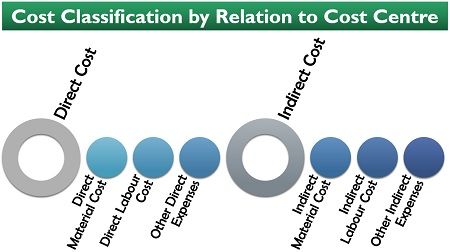
- Direct Cost: Direct cost is the significant cost immediately associated with a production process. It can be seen as a prime cost for any business. It is sub-divided into direct material cost, direct labour cost and other direct expenses.
- Indirect Cost: Indirect cost is the cost which cannot be directly allocated to a particular process of production. It is a secondary cost and is majorly seen as of three types – indirect material cost, indirect labour cost and other indirect expenses.
Cost Classification by Functions
The cost can also be classified by the business functions for which the resources have been used.
There are five significant functions of a business which involves some expense and are essential to the organisation in their way. The cost involved in such business operations are explained below:
- Production: Production cost comprises of all the direct and indirect costs incurred in the production of goods and services.
- Administration: The costs involved in the management activities of an organisation like electricity, stationery, telephone expenses, rent etc. These are also known as administrative overheads.
- Selling: The indirect costs incurred on the sales function of the goods and services like an advertisement, promotion, research, customer service, etc. are clubbed under selling cost.
- Distribution: Distribution cost refers to the cost incurred for making the goods or services available to the customers. These are warehousing, delivery service, transportation, etc.
- Research and Development: Reseach is essential to develop a new product or modify an existing one. The cost incurred on the research team, research implementation, findings, etc. comes under this category.
Cost Classification by Behaviour
The cost involved in any business process can be differentiated on the grounds of its volatility concerning the fluctuation in business activity in the short run.
The following classification of cost by its behaviour will give a clear illustration of the above statement: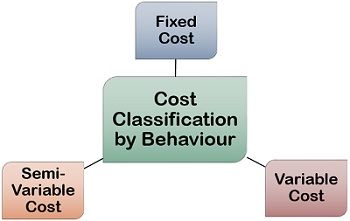
- Fixed Cost: The cost which is hardly affected by the temporary change taking place in business activity is known as a fixed cost. It includes rent, depreciation, lease, salary, etc.
- Variable Cost: The cost which changes proportionately with the change in production quantity or other business activity is termed under variable cost. Raw material, packaging, sales commissions, wages, etc. are variable costs.
- Semi-Variable Cost: The cost which is moderately influenced by the change in business activity is called semi-variable cost. It includes power consumption, maintenance cost, management cost, supervision cost, etc.
Cost Classification by Management Decision Making
Cost is not just a price paid to generate some value, but it is also used as a tool by the management for decision making.
Managerial decisions are framed depending upon the following types of cost involved in carrying out of business: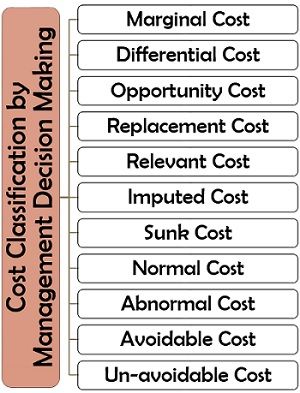
Marginal Cost: Marginal cost is the cost of producing an additional unit and its impact on the total cost of production.
Differential Cost: When there is an increment or decrement in the cost of bulk production, the change in the cost of a single unit is also determined which is known as differential cost.
Opportunity Cost: The value of one or more products given up to acquire the desired product or service is known as opportunity cost. For instance; while choosing green tea, a person has to give up the value he must have derived from coffee or regular tea.
Replacement Cost: When machinery or any other asset becomes obsolete or involve high maintenance cost, and simultaneously a better asset is available in the market which can replace it, then the cost involved in such substitution is known as replacement cost. For example; a transportation company needs to replace its trucks from time to time to avoid excessive repairing expenses.
Sunk Cost: The cost which has been born by the organisation in the past and cannot be recovered at any stage of the business process is termed as a sunk cost. Freight inwards paid at the time of buying machinery has to be written off at the time of selling it.
Normal Cost: The routine cost associated with the manufacturing of goods or services under usual circumstances is called a normal cost. It includes all direct expenses such as salary, material, rent, etc.
Abnormal Cost: The cost that arises suddenly and unknowingly under unfavourable situations is known as abnormal cost. For instance; workers go on strike, theft or robbery, fire in the premises, etc.
Avoidable Cost: Such costs are under the control of management and can be prevented as per the organisational need. For example; an enterprise upgrades its technology by installing self-operative machines to avoid the labour charges it pays.
Unavoidable Cost: The cost which is pre-determined and inevitable is called an unavoidable cost.
Cost Classification by Production Process
This basis of cost classification is significantly applicable in the manufacturing industries or factories where goods are produced.
All production or manufacturing activities involve different types of costs. According to the nature of the production process, these costs can be classified as below: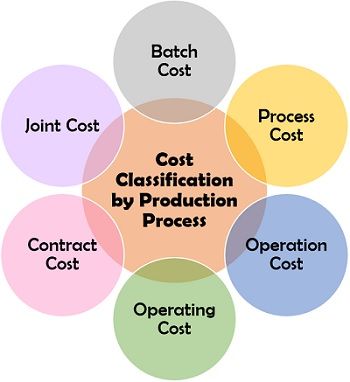
- Batch Cost: The cost incurred while producing a whole lot comprising of identical products (batch) is known as batch cost. Each batch differs from the other, and the units lying under a batch are identified by their batch number. Pharmaceuticals, automobiles, electronic products are some of the examples.
- Process Cost: The cost incurred on performing different operations in a streamlined production process is termed as a process cost. By dividing the total cost of a process with the number of units produced, we can derive the process cost of a single unit or product.
- Operation Cost: The cost involved in a particular business function contributing to the production process is known as operation cost. It helps in regulating the mechanism of business activities by monitoring the cost incurred on each business operation.
- Operating Cost: Operating cost refers to the day to day expenses incurred by an organisation to ensure uninterrupted functioning of the business is known as an operating cost.
- Contract Cost: The cost of entering into a contract with a buyer or seller by mutually agreeing to the terms and conditions so mentioned is called a contract cost. It includes a bidding contract, price escalation contract, tenders, etc.
- Joint Cost: The combined cost involved in the production of two or more useful products simultaneously is known as the joint cost. For example; the cost of processing milk to get cottage cheese and buttermilk.
Cost Classification by Time
The nature, importance and liability of a cost vary as per the time it takes place or has been assessed.
A cost which is a priority today, may not be that important tomorrow or a cost which has been overlooked today, may be considered as a relevant cost tomorrow.
Thus, depending upon the period a cost has occurred or assessed, it can be categorised under the following heads: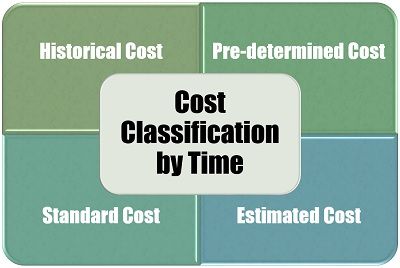
- Historical Cost: Any actual cost ascertained and evaluated after it has been incurred, is termed a historical cost. It can be committed either on the production of goods and services or asset acquisition.
- Pre-determined Cost: The cost which can be identified and calculated before the production of goods and services based on the cost factors and data is called a pre-determined cost. It can be either a standard cost or an estimated cost.
- Standard Cost: An actual cost which is pre-determined as per certain norms and guidelines to provide as a base for cost control, is termed as a standard cost.
- Estimated Cost: The cost of business operation presumed on the grounds of experience is known as an estimated cost. It is merely based on assumptions and therefore considered to be less accurate to determine the actual cost.
Conclusion
Cost classification has simplified the work of the management, accountants, economists, researchers and many others. It facilitates the process of cost control, cost reduction and cost management.
Baligwibwa Alfred says
Very elaborate presentation on cost classification. Thank you.
fransisca says
thanks very much indeed keep it up to assisted the student i noted you input and i need your referent. next time
Kapil says
This is an excellent explanation and representation.